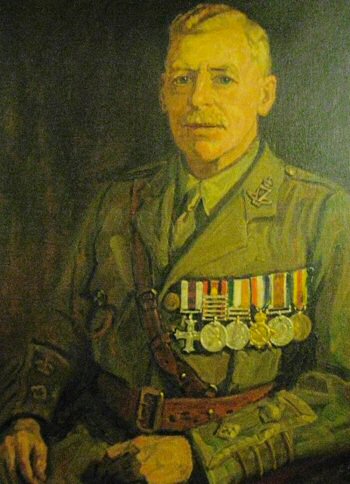
Lieutenant-Colonel Thomas Hutchesson
Royal Irish Regiment

Military Cross
GUERNSEY’S losses in the First World
War through death and injury were immense and quite
disproportionate for such a small community. We were
rightly reminded of this in 2017 when many Guernsey
families remembered relatives who lost their lives 100
years ago fighting with the Royal Guernsey Light Infantry
in the battles at Cambrai and Les Rues Vertes in November
1917. This year, those who fell at Doulieu in April
1918 will also be remembered.
Others who fought in that appalling conflict
survived and returned home, physically unscathed if
mentally scarred, to piece together their lives. Such
men, uncommemorated on rolls of honour and war memorials,
may also, if they remained childless, have left no one
to remember them.
One such is Thomas Hutchesson (Old Elizabethan
2509), born in Guernsey on 19 January 1879, the third
child of Francis Pery Hutchesson, manager of the Old
Bank, and Seigneur of the Fief Le Comte, and Charlotte
Frederica Elizabeth, née Hay-Graeme.
As a boy Thomas lived with his family
in the Oberlands, St Martin’s.
He attended Elizabeth College from 1888
to 1893, but left aged 14 and attended the Séminaire
et Collège at Valognes in Cherbourg, presumably
to improve his French.
He didn’t stay long. In 1894, aged
just 15, he set sail to join the gold rush in Western
Australia. There he remained until at the outbreak of
the Second South African (Boer) War in 1899 he enlisted
with the Western Australian Permanent Infantry as a
private. His unit soon converted to horseback and served
from 1900 as the Western Australian Mounted infantry
until the war ended in May 1901.
Thomas served throughout, earning the
Queen’s South Africa Medal with five clasps and
the King’s South African Medal with two bars. He
clearly made his mark as both horseman and soldier and
in addition to his other campaign honours he became
galloper to General Sir John French and was mentioned
twice in despatches.
Returning to Guernsey in 1902, Thomas
joined the RGLI as lieutenant, becoming captain in 1904.
In 1906 he inherited the Seigneurie Le Comte from his
father and his grandfather before him. In this time
his residence seems to have changed from St Martin’s
to Les Touillets in the Castel, but very soon after
his father’s death he went to Brazil to set up
as a rubber planter and stayed there until 1910.
In 1913 he married Ada, nee Wilde-Rice,
from Lancashire, but sadly, just two years later she
died, perhaps of complications to do with childbirth.
She left £147 in effects.
On 14 February 1915 Thomas was appointed
captain (temporary) in the Royal Irish Regiment.
After training in Ireland he went to France
with D Company in December 1915 and took command of
the Machine Gun Detachment as a captain. On 8 December
1916 he was promoted to major, taking over as second
in command of the 6th Battalion RIR, and a year later
he was promoted to lieutenant-colonel.
On 1 January 1918 he was awarded the Military
Cross and transferred to command the 19th London Regiment
in January 1918, which post he held until December 1918.
In late 1918, he married his second wife,
Louise Violet Winifred Holland. He was aged 40, she
34.
From March to July 1919 he was given command
of the 15th Battalion West Riding Regiment, Rhine Army
and then transferred to Dublin to command the 52nd Welsh
Regiment, a post he held until its demobilisation and
his release from active service on 16 March 1920.
Subsequently he commanded the 1st Battalion
Royal Guernsey Light Infantry (Militia) for 18 months
and then was placed on the Officer Reserve List for
the Royal Guernsey Militia as a major.
On his return to Guernsey, Thomas Hutchesson
had a crucial role in the setting up of D Company and
the men of other Irish Regiments, e.g. the Fusiliers
and the Rifles, as firstly the Royal Irish Association
(31 March 1919) and then the Guernsey Sporting Club
(13 January, 1920), and negotiating the purchase of
Warwick House.
The minute book shows him as very active
and involved up until 1923, when it reads, on 1 June,
of ‘the president’s absence from the island’
and a comment in the same minute that the 16 and 19
March minutes had not been signed by the president.
However, in 1924, at the annual general meeting, Thomas
is reported as expressing a strong opinion about the
importance of the club and the need to stay true to
the spirit of its foundation.
Then the record falls silent.
He may have returned to Brazil to attend
to his rubber plantation, as on 7 December 1930 he is
recorded as disembarking as a first class passenger
in London from the Andalucian Star of Blue Star Lines,
which had originated in Buenos Aires, picking up more
passengers in Rio de Janeiro en route.
During the 1930s he continued to live
at Les Touillets, Castel, and to play his role in the
community as Seigneur of the Fief Le Comte, and an active
member of the Castel parish community.
He died in Weymouth on New Year’s
Day 1940, just short of his 61st birthday. Probate lists
his effects as valued at £1,020 6s 5d, granted
to his widow Louise, with his brother Charles acting
as joint executor.
Louise lived on to the age of 88, dying
in Surrey in 1972.
Thomas is buried in the family tomb in
Candie Cemetery.
Alan Cross
Archivist for the Guernsey Sporting Club.